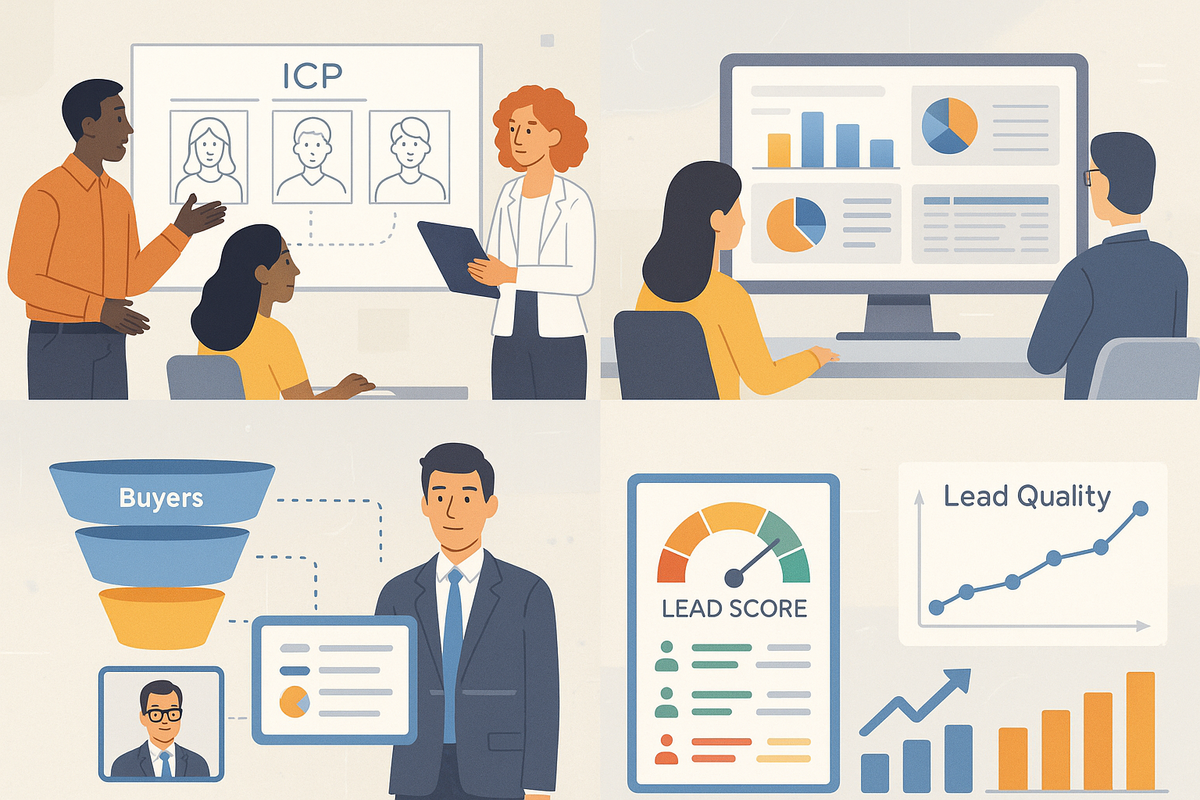A well-defined Ideal Customer Profile (ICP) is more than a box-checking exercise. It’s the foundation for marketing that respects time, budget, and sales alignment.
When your ICP is vague, your lead quality suffers. Sales wastes time on bad fits. Marketing loses credibility. Campaign ROI flatlines. But when your ICP is built with precision, your targeting becomes sharper and your conversions more predictable.
Content syndication campaigns, in particular, live and die by ICP clarity. These campaigns don’t just amplify content. They put it in front of decision-makers. If your targeting is even slightly off, you flood your funnel with leads who will never convert.
Getting the ICP right is not about perfection. It’s about continuous refinement based on campaign performance and grounded assumptions. Tailoring your approach to specific buyer personas (e.g. CMO, Sales Director, IT Manager) – is no longer optional; it’s a strategic necessity
What an ICP Should (And Shouldn’t) Be
A usable ICP is not a vague persona or a wishlist of dream clients. It’s a practical filter that aligns with your product’s actual impact zones.
It should define:
- The type of company where your solution creates value
- The roles and functions most likely to feel the need
- The signals that indicate readiness or fit
The ICP should also include who not to target. Exclusion is as important as inclusion when it comes to keeping lead quality high.
Start With Firmographic Filters That Make Sense
Firmographics are your first line of qualification. The common mistake is going too broad or using arbitrary categories like "enterprises in North America." Instead, work backwards from data. Review the last 12–18 months of closed-won deals and look for patterns.
Focus on:
- Industry: Go deeper than high-level verticals. A healthcare SaaS vendor may sell well into diagnostic labs but not hospitals.
- Company size: Use employee range or revenue, but correlate with deal size and sales cycle length.
- Location: Account for compliance, data residency, or market maturity if relevant.
Avoid guessing. If certain regions or industries never close, remove them early.
Add Technographics for Precision Targeting
Technographics sharpen your profile by aligning your offer with a company’s existing stack.
For example:
- A cybersecurity tool might only be effective in AWS-native environments.
- An integration product might require the prospect to be using Salesforce, not Zoho.
- A scheduling tool may complement Outlook but be redundant for Google Workspace users.
Rather than build broad campaigns and filter later, use technographic criteria to control exposure from the start. This reduces noise and increases the relevance of your content.
Map the Buying Group, Not Just a Single Title
Buying decisions are no longer made by one person. Multiple stakeholders with different priorities influence the purchase. Your ICP should reflect that.
Break down your internal audience as:
- Economic buyers: Budget holders
- Technical evaluators: Gatekeepers and validators
- User influencers: Teams who experience the pain directly
This informs not only who to target, but what content to syndicate. A CFO needs something different than a product manager. Your campaign should be structured to reflect this range of needs, even if the primary goal is lead capture.
Refine Based on Real Campaign Feedback
A good ICP on paper can still fall apart in execution. You may find that a certain industry has high engagement but zero pipeline impact. Or that mid-market companies convert faster than enterprise accounts.
Track:
- Lead quality by segment: Are certain industries or geographies more likely to convert?
- Sales feedback: What are the common reasons leads are rejected?
- Asset engagement: Are certain job functions engaging more than others?
The goal is to turn your campaign into a feedback loop. If the data tells you a specific buyer type isn’t responding, either change your message or remove that segment from future runs. Don’t keep targeting a profile just because it looks good on a slide.
Avoid Overfitting or Overgeneralizing
Not every high-converting deal should change your ICP. One-off wins from unexpected sectors are outliers, not signals. Similarly, avoid building a profile that is so broad it becomes meaningless.
Use trends, not anecdotes, to inform refinement. If five out of your last six closed-won deals came from companies using a specific tech stack, that’s a valid technographic signal. If one massive deal came from a sector you’ve never sold to before, that doesn’t warrant a full pivot.
Refining your ICP should be about pattern recognition, not optimism.
Make It Actionable for Content Syndication
Once you’ve defined and validated your ICP, make sure it translates directly into campaign targeting. If you’re using a content syndication partner, ensure they can filter leads by:
- Industry
- Geography
- Company size
- Role or function
- Technographic stack
This allows your campaign to start clean, without the usual volume-quality tradeoff.
Platforms that support multi-layer filtering will help you execute on your ICP as planned, not just in theory. They also allow you to test variables across audience segments, which accelerates refinement.
Closing Thought
A good ICP isn’t static. It’s something you pressure test, iterate, and rebuild as your product evolves and your market shifts. For lead generation campaigns to deliver real value, the ICP must be more than a demographic sketch.
It should be a live, working profile that directs targeting, content, and follow-up — and adapts based on what’s actually working in-market.
And when your ICP is clear, focused, and measurable, your lead quality improves. Sales alignment tightens. And your marketing programs stop chasing interest and start delivering intent.
Ready to Activate Your ICP with High-Intent Leads?
Host your whitepapers on platforms that support advanced ICP targeting, lead filtering, and real-time engagement insights.
Discover how Whitepapers Online helps you match content with the right decision-makers

